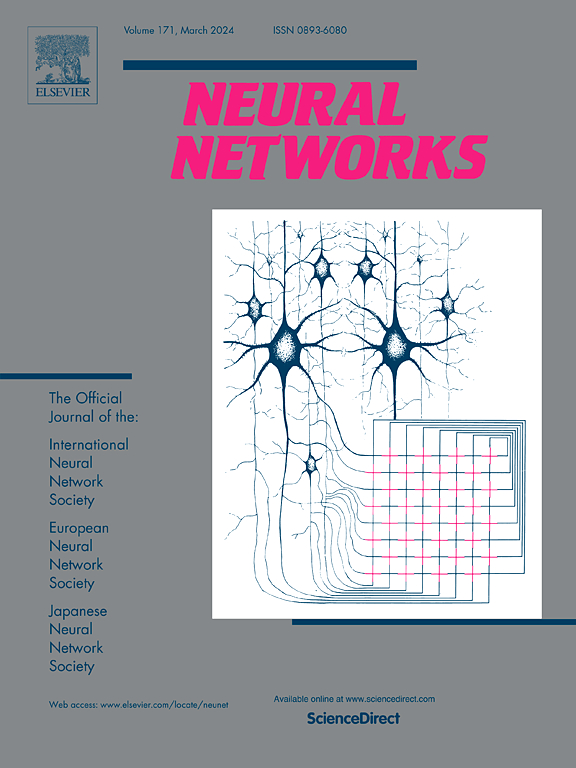CLPNets: Coupled Lie–Poisson neural networks for multi-part Hamiltonian systems with symmetries
IF 6
1区 计算机科学
Q1 COMPUTER SCIENCE, ARTIFICIAL INTELLIGENCE
引用次数: 0
Abstract
To accurately compute data-based prediction of Hamiltonian systems, it is essential to utilize methods that preserve the structure of the equations over time. We consider a particularly challenging case of systems with interacting parts that do not reduce to pure momentum evolution. Such systems are essential in scientific computations, such as discretization of a continuum elastic rod, which can be viewed as the group of rotations and translations . The evolution involves not only the momenta but also the relative positions and orientations of the particles. The presence of Lie group-valued elements, such as relative positions and orientations, poses a problem for applying previously derived methods for data-based computing. We develop a novel method of data-based computation and complete phase space learning of such systems. We follow the original framework of SympNets (Jin et al., 2020) and LPNets (Eldred et al., 2024), building the neural network from phase space mappings that preserve the Lie–Poisson structure. We derive a novel system of mappings that are built into neural networks describing the evolution of such systems. We call such networks Coupled Lie–Poisson Neural Networks, or CLPNets. We consider increasingly complex examples for the applications of CLPNets, starting with the rotation of two rigid bodies about a common axis, progressing to the free rotation of two rigid bodies, and finally to the evolution of two connected and interacting components, describing the discretization of an elastic rod into two elements. Our method preserves all Casimir invariants to machine precision, preserves energy to high accuracy, and shows good resistance to the curse of dimensionality, requiring only a few thousand data points for all cases studied (three to eighteen dimensions). Additionally, the method is highly economical in memory requirements, requiring only about 200 parameters for the most complex case considered.
多部分对称哈密顿系统的耦合Lie-Poisson神经网络
为了准确地计算基于数据的哈密顿系统的预测,利用保持方程结构随时间变化的方法是必不可少的。我们考虑一个特别具有挑战性的情况,系统的相互作用部分不减少到纯动量演化。这样的系统在科学计算中是必不可少的,例如连续弹性杆的离散化,它可以被看作是旋转和平移的一组SE(3)。演化不仅涉及动量,还涉及粒子的相对位置和方向。李群值元素(如相对位置和方向)的存在给应用先前导出的基于数据的计算方法带来了问题。我们开发了一种新的基于数据的计算方法和这种系统的完全相空间学习方法。我们遵循SympNets (Jin et al., 2020)和LPNets (Eldred et al., 2024)的原始框架,从保持Lie-Poisson结构的相空间映射构建神经网络。我们推导了一个新的映射系统,该系统被内置到描述这种系统进化的神经网络中。我们称这种网络为耦合李泊松神经网络(CLPNets)。我们考虑了CLPNets应用的越来越复杂的例子,从两个刚体围绕一个共同轴的旋转开始,进展到两个刚体的自由旋转,最后到两个连接和相互作用的SE(3)分量的演变,描述了弹性杆的离散化为两个元素。我们的方法保留了机器精度的所有卡西米尔不变量,保留了高精度的能量,并且对维数诅咒表现出良好的抵抗力,对于所有研究的情况(3到18维)只需要几千个数据点。此外,该方法在内存需求方面非常经济,对于最复杂的情况只需要大约200个参数。
本文章由计算机程序翻译,如有差异,请以英文原文为准。
求助全文
约1分钟内获得全文
求助全文
来源期刊

Neural Networks
工程技术-计算机:人工智能
CiteScore
13.90
自引率
7.70%
发文量
425
审稿时长
67 days
期刊介绍:
Neural Networks is a platform that aims to foster an international community of scholars and practitioners interested in neural networks, deep learning, and other approaches to artificial intelligence and machine learning. Our journal invites submissions covering various aspects of neural networks research, from computational neuroscience and cognitive modeling to mathematical analyses and engineering applications. By providing a forum for interdisciplinary discussions between biology and technology, we aim to encourage the development of biologically-inspired artificial intelligence.
 求助内容:
求助内容: 应助结果提醒方式:
应助结果提醒方式:


